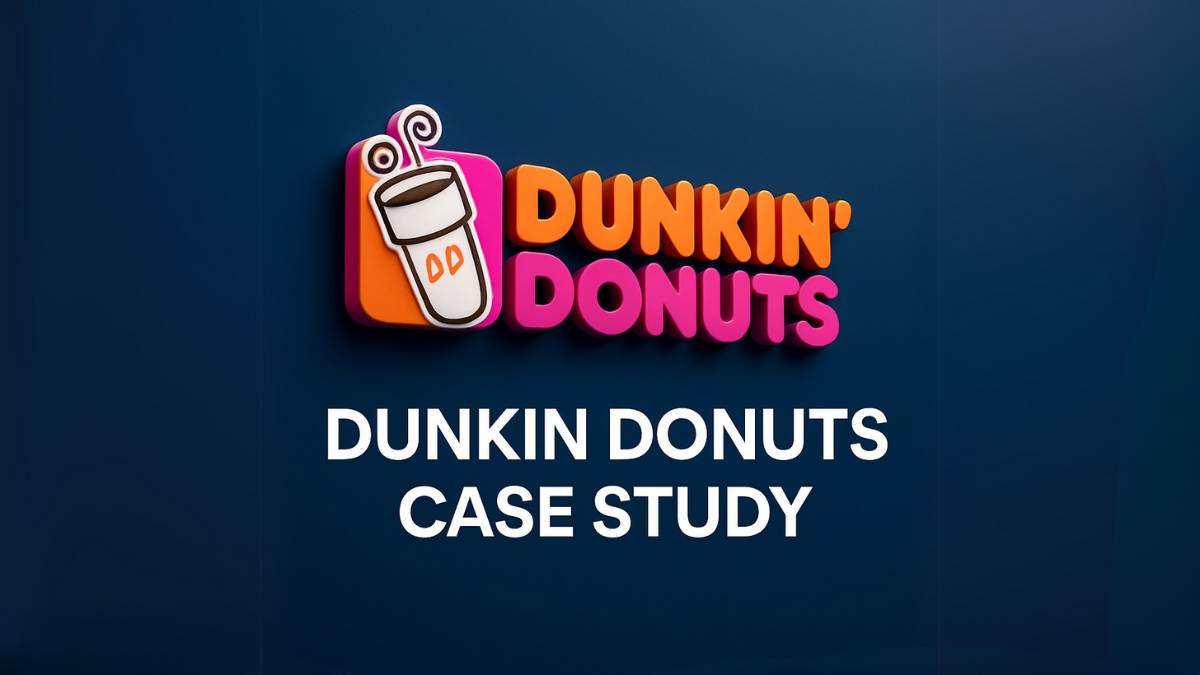When you think of Dunkin, what comes to mind first? Coffee? Donuts? Maybe even TikTok collabs. But behind that familiar pink-and-orange logo is one of the best examples of brand reinvention in recent years.
From a small donut shop in Massachusetts to a global beverage giant, their journey is packed with clever marketing moves and powerful brand lessons. And that’s exactly what we’re going to explore in this Dunkin’ Donuts case study – with a special look at how these strategies matter globally, including fast-growing markets like India.
Let’s break it down.
Table of Contents
Why Dunkin’ is More Than Just Coffee
Dunkin isn’t just about coffee or donuts – it’s a masterclass in branding, adaptation, and customer focus.
- Brand Identity → Simple, approachable, everyday.
- Positioning → For people on the go. Fast, affordable, reliable.
- Global Impact → While huge in the U.S., it’s been steadily expanding across Asia, including India, where international coffee chains are becoming increasingly popular.
The Origin Story: From “Open Kettle” to Dunkin’
Here’s how it all started:
- Founder: William Rosenberg
- Year: 1950
- Place: Quincy, Massachusetts
- Original Name: Open Kettle → Later renamed to Dunkin’ Donuts → Finally became Dunkin’ in 2019
Why the name “Dunkin’ Donuts”?
Because people were literally dunking their donuts into coffee. Straightforward branding – works even today.
Fun Fact for India:
In India, coffee culture is evolving fast, with global players like Starbucks, Costa, and Dunkin’ trying to grab market share alongside beloved local favorites like Filter Coffee and Cafe Coffee Day (CCD).
Also Read: Zara Case Study
Brand Positioning: “Coffee for the Hustlers”
Dunkin’s messaging has always been about serving the people who get things done.
🔸 Tagline: “America Runs on Dunkin’”
🔸 What It Means: Energy for busy routines. Coffee = fuel for life.
🔸 Audience Evolution:
- Early Days → Working-class, blue-collar workers
- Now → Millennials, Gen Z, students, office-goers, entrepreneurs
Key Differentiators:
- Affordable, fast, easy → Great for people who don’t want to sit in a café for hours
- Competes with → Starbucks globally, CCD and Starbucks in India
- Global Personality → Chill, fun, slightly rebellious – very “TikTok generation” friendly
Also Read: McDonald’s Case Study
Dunkin’ Donuts Marketing Strategy Breakdown
Let’s unpack Dunkin’s approach across marketing channels:
1. Traditional Advertising
- Mediums Used → TV, radio, billboards
- Messaging → Speed, routine, affordability
- Famous Campaign → “Time to make the donuts” (iconic in Western markets)
2. Digital Marketing Strategy (Where They Really Shined)
Here’s where Dunkin became a pop-culture icon:
Influencer Marketing:
- Viral partnership with Charli D’Amelio on TikTok
- Result: Millions of young followers tried “The Charli” drink
Social Media Tone:
- Casual, fun, meme-friendly
- Relatable to younger audiences
Mobile App & Loyalty Programs:
- Rewards for repeat buyers
- Order ahead features → Boost in sales
- India Focus: With rising UPI usage and food delivery apps like Zomato & Swiggy, Dunkin’ could integrate local loyalty programs smartly.
SEO + Local Search Optimization:
- Dominating Google Maps for “coffee near me” searches globally
- Essential for increasing footfalls in physical outlets
Want to learn how brands build winning digital campaigns? We teach these inside our Digital Marketing Course at Young Urban Project.

3. Experiential Marketing
- Pop-ups – Special events, collabs with other brands
- Menu Collabs – Example: Charli D’Amelio drink, Oreo-flavored beverages
- Personalization – Through app-driven offers based on your purchase habits
Key Learning – Make your audience feel like part of something exclusive.
Especially relevant in India’s metro cities where experience-based marketing works wonders.
Also Read: Coca-Cola Case Study
Rebranding to “Dunkin”: Why It Was Genius
- Why Drop ‘Donuts’? To show the world: “We’re not just about donuts anymore. We’re serious about beverages.”
- What Changed:
- New, minimalist logo
- Store revamps with cleaner, more modern designs
- Digital branding that looks great on social media
- New, minimalist logo
- Impact – Stronger competition against Starbucks, especially in iced beverages and cold brews (which are booming globally)
Also Read: Uniqlo Case Study
Product Innovation: Beyond Just Coffee & Donuts
For a long time, Dunkin was seen as “that donut place with coffee.” But to survive and grow globally, they needed more. And they delivered.
1. Beverage Innovation:
- Cold Brews & Iced Lattes – Perfect for younger, urban customers
- Flavored Drinks – Caramel, mocha, hazelnut – fan favorites
- Customizable Orders – Through mobile apps, Consumers could tweak sweetness, flavors, milk alternatives
Why It Matters Globally:
Cold coffee, iced drinks, and customization have become a global trend, including in Indian metros like Mumbai, Delhi, Bangalore, and Pune.
2. Food Diversification:
- Beyond Donuts – Breakfast sandwiches, bagels, croissants
- Plant-Based Options – Collaborations like Beyond Meat, Worked well in western markets; vegetarian/vegan menus can be localized for markets like India
- Regional Twists – In India, local flavors like Paneer Tikka Sandwiches were introduced to fit local tastes
3. Digital-First Innovation:
- App-based exclusive items or pre-launch flavors for loyal users
- Limited edition drops → Creates hype → FOMO marketing → Especially strong among younger, social-media-savvy audiences
Also Read: Netflix Case Study
Global Expansion Strategy: Going Beyond the U.S.
Expanding globally isn’t easy – and Dunkin learned that firsthand.
Markets Where Dunkin Succeeded:
- South Korea – Localization with regional flavors
- Philippines – Donut culture fits well with local tastes
- Middle East (UAE, Saudi) – Focus on family-oriented outlets with varied menu options
Markets Where Dunkin Struggled:
- U.K. – Tough competition, strong local cafe culture
- China – Starbucks dominated premium positioning
India Focus:
- Entered India in partnership with Jubilant FoodWorks (same company that operates Domino’s India)
- Customized offerings – More vegetarian options, spice levels adjusted
- Challenges – Heavy competition from Starbucks, Costa, local cafes, CCD, and premium boutique coffee chains
Lesson – Global brands must localize to survive. What works in Boston doesn’t automatically work in Bangalore.
Also Read: Amul Case Study
Dunkin’ vs. Starbucks: The Real Coffee Battle
Everyone talks about Starbucks when discussing coffee chains, but Dunkin plays a different game.
| Factor | Dunkin | Starbucks |
| Pricing | Affordable | Premium pricing |
| Brand Voice | Casual, playful | Sophisticated, aspirational |
| Experience | Grab & go, fast | Sit, work, hangout |
| Menu | More sweet, breakfast-heavy | More artisanal, cafe-centric |
| Audience | Students, office-goers, everyday earners | Professionals, premium buyers |
Why Dunkin’ Wins in Some Markets:
- Price-sensitive locations – Dunkin appeals to value-seekers
- Younger audiences – More likely to resonate with TikTok campaigns, influencer partnerships
- Simplicity – In markets where coffee is fuel, not an “occasion”
In India? Starbucks plays the luxury cafe game well. Dunkin could double down on value meals, youth collabs, and regional flavors to grow further.
Also Read: Starbucks Case Study
Business Lessons & Marketing Takeaways for Founders & Marketers
This is where it gets really useful for entrepreneurs and marketers 👇
1. Know Your Customer’s Routine
- Dunkin wasn’t selling coffee; they were selling a daily ritual.
- Brands that become part of people’s routines win.
2. Don’t Be Afraid to Rebrand
- Changing from Dunkin’ Donuts to Dunkin’ wasn’t just cosmetic – it opened new business opportunities.
- Lesson – If your brand positioning is holding you back, evolve.
3. Go Digital Early
- Dunkin invested in apps, influencer collabs, and loyalty programs before many of its competitors.
- In India, with booming digital payments and social media growth, this lesson is more relevant than ever.
4. Collaborate With Culture
- The Charli D’Amelio partnership wasn’t random – it was strategic.
- Smart collabs drive organic attention, especially from Gen Z and younger millennials.
5. Localize to Globalize
- Cookie-cutter menus don’t work globally.
- Successful expansions = regional menu tweaks + cultural alignment
Also Read: Apple Marketing Case Study
Conclusion
If there’s one thing Dunkin’s story proves, it’s this: you don’t have to be fancy to win. You just need to know your audience and grow with them. Dunkin didn’t try to be like Starbucks. They stayed true to what they were – quick, affordable, familiar. But they weren’t afraid to change either. Dropping ‘Donuts’, launching app rewards, doing TikTok collabs – they kept moving with the times. And that’s the real lesson here. Whether you’re a small brand or building something big, the brands that listen, adapt, and stay close to their customers always come out ahead. Simple, but not easy.
FAQs: Dunkin’ Donuts Case Study
1. Why did Dunkin’ Donuts change its name?
They dropped ‘Donuts’ to show they’re more about coffee now. Donuts are still there, but drinks drive most sales.
2. How did Dunkin’ win at digital marketing?
They used TikTok influencers, made fun content, and pushed their app hard. Loyalty points kept people coming back.
3. What makes Dunkin’ different from Starbucks?
Dunkin’s all about quick, cheap, no-nonsense coffee. Starbucks is more premium, sit-down, work-from-café vibe.
4. Where does Dunkin’ do really well globally?
East Coast USA is their home ground. Also solid in South Korea and the Philippines. India’s been steady but competitive.
5. Was the Charli D’Amelio collab a big deal?
Yep, massive. Charli brought in Gen Z fans and made Dunkin cool again online. It wasn’t just a drink – it was hype.
6. Biggest lesson from Dunkin’s marketing story?
Stay close to your customers. Be flexible. And don’t be afraid to collab with pop culture to stay relevant.

